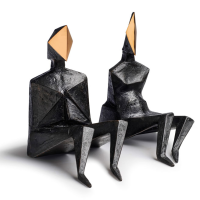74. LYNN CHADWICK

Lynn Chadwicks career will always be remembered for one extraordinary moment, when he represented Great Britain at the Venice Biennale of 1956, and won the International Sculpture Prize. The Englishman was a surprising and controversial choice because it was widely believed the recipient should have been Alberto Giacometti (1901-1966). It had been a convention that the prize was awarded for lifetime achievement as much as for the work displayed in the Biennale, and at 55 years of age, Giacometti was fourteen years older than Chadwick.
Whether justice was done or not, the prize gave a tremendous boost to Chadwicks reputation. His work had already been collected outside of Britain, but this made him a figure of international renown. It wasnt his first success in Venice, as he had attracted significant attention at the Biennale of 1952, as part of a group of young British sculptors, including Kenneth Armitage (1916-2002), Reg Butler (1913-1981), Eduardo Paolozzi (1924-2005), and William Turnbull (1922-2012).
In the catalogue essay, Herbert Read had coined the memorable phrase, the geometry of fear, which would eventually become a Cold War clich for most of the artists concerned. Chadwick, who always disavowed literary interpretations of his work, was happy to distance himself from the whole business. Nevertheless, it's worth looking at the key passage in Reads essay, as it gives a vivid impression of the atmosphere in which modern art was being made and presented:
These new images belong to the iconography of despair, or of defiance; and the more innocent the artist, the more effectively he transmits the collective guilt. Here are images of flight, of ragged claws scuttling across the floors of silent seas, of excoriated flesh, frustrated sex, the geometry of fear.1
Within the space of two sentences, Read dived headlong into post-war guilt, Cold War paranoia and existentialist malaise. The quotation is from T.S. Eliots defiantly unheroic poem, The Love Song of J. Alfred Prufrock (1915).
One can see how these sentiments might be applied to the sculptures Chadwick was making at the time. His forms were spiky, rough-textured, and largely abstract. They had the belligerent air of monstrous, armour-plated insects. Like many of his contemporaries, Chadwick had turned his back on conventional beauty, reducing the human form to a collection of planes and angles.
In the catalogue of Chadwicks Tate retrospective of 2004, Dennis Farr repeatedly tells us how the artist was only comfortable speaking about his work in formal terms.2 This may have been a necessary defence mechanism at a time when abstraction seemed the only valid language for an avant-garde artist, but looking back on Chadwicks work today, he seems more of a humanist than a formalist.
Maquette II Diamond dates from 1984, when Chadwicks work had settled into a set of iconic forms that were repeated with numerous variations. His trademark motifs were the triangular or diamond-shaped heads that he bestowed on female figures, while their male counterparts had rectangular cuboid versions. The idea was to create archetypes with no distinctions of age, creed, or colour. All we can know, with any certainty, is that a figure is either male or female. In the 1980s, gender fluidity was not a social issue of burning importance!
That said, in Maquette II Diamond there is more ambiguity than usual. The figure on the right is unmistakably female, but her diamond-headed, square-shouldered companion looks suspiciously male. It seems Chadwick was prepared to break his own rules from time to time.
He was unapologetic about his figures lack of arms, saying the Venus de Milo probably looked better that way. The legs are rudimentary, a trait that almost qualifies as another Chadwick trademark.
The sculptor had begun using the geometrical head shapes in the 1960s, and would continue with them until the late 1990s, when declining health forced him to retire from making sculpture. When people think of Chadwicks work today, its the triangular heads that spring most readily to mind, but it may be more revealing to think about the figures and what they are doing. Sitting on a bench, lounging on the grass, striding into the wind, or passing on the stairs, Chadwick depicts a wide range of everyday activities.
These works are a far cry from his creations of the 1950s and reveal him as a more traditional sculptor than suggested by those aggressive early works. His fundamental subject is the human figure, and by extension, the human condition. The geometric heads may be symbols of modernity, but the figures are often portrayed in casual repose, sitting quietly or walking, on a scale that ranges from desktop to monumental. The change of tone that occurred with these sculptures may reflect Chadwicks own increasing sense of ease and security, or it may be in response to the way he saw the planet. By nature, he claimed to be apolitical and reclusive, happy to live and work in the country. Perhaps we should see the duo in Maquette II Diamond, not as egoists, demanding attention, but as spectators who sit quietly and watch the world go by.
Footnotes:
1. Read, H., New Aspects of British Sculpture [exhibition catalogue], British Council, London, 1952
2. Farr, D., Lynn Chadwick, Tate Publishing, London, 2003
John McDonald
John McDonald is the author of Jeffrey Smart: Paintings of the 70s and 80s. He writes a weekly art column for the Sydney Morning Herald and a weekly film column for the Australian Financial Review.